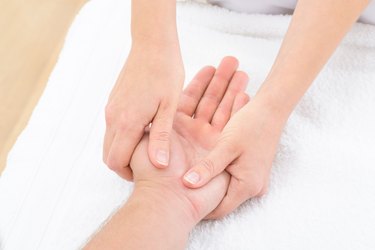
Jammed finger injuries range from mild sprains to dislocations. Many times a jammed finger occurs without showing symptoms other than pain. Even if you can move your finger, it can be jammed. Untreated jammed fingers can lead to arthritis or other debilitating conditions, according to the Hospital for Special Surgery. Jammed finger exercises involve simple stretching and strengthening that help rehabilitate and protect your hand from further injury. Check with your doctor prior to starting.
Wrist Maneuver
Video of the Day
Strengthening your wrists will help your jammed finger, according to the Hospital for Special Surgery. Use either a one- or two-pound hand weight, can of soup or sock filled with beans for this exercise. Sit upright in a firm chair with arm rests. Place your injured-side arm onto the arm rest, palm facing up. Slide your arm so your wrist is unsupported, according to the National Institute on Aging. Place the weight into your injured-side palm. Slowly lower the weight downward while bending your wrist toward the floor. Hold this position for five seconds. Slowly lift the weight to the original position, with your wrist neutral. Relax for eight seconds. Gently and slower lift the weight toward the ceiling while bending your wrist upward. Hold this position for five seconds. Return your wrist and weight to the original position. Repeat this exercise two times.
Video of the Day
Finger Flexing
Stretch your finger tendons by doing assisted finger stretches, according to the National Institute for Health and Clinical Excellence. Sit upright in a firm chair. Bend your affected-side elbow at a 90-degree angle. Lift your injured hand, with your palm facing toward your body. Use your unaffected-side hand to gently bend your jammed finger toward your palm. Hold this position for 10 seconds. Gently and slowly return your finger to the original position. Repeat this exercise 10 times.
Assisted Finger Moving
Stretch your jammed finger tendons by doing an assisted finger bend, according to the National institute for Health and Clinical Excellence. Start doing this exercise while in a splint. Bend your affected-side elbow at a 90-degree angle. Keep your elbow at your side. Use your unaffected-side hand to gently straighten your jammed finger toward the splint. Touch your fingertip to the splint, if possible. Hold this position for six seconds. Slowly return your affected finger to the original position. Relax for 10 seconds. Repeat this exercise three times.
Finger Resistance
Strengthen your jammed finger muscles and tendons by doing a rubber band exercise, according to the Hospital for Special Surgery. Use a medium-width rubber band. Either stand or sit for this exercise. Place the rubber band around the tips of your affected-side fingers and thumb, according to the physical therapy business Nicholas Institute of Sports Medicine and Athletic Trauma. Lift your forearm so your elbow is at a 90-degree angle. Slowly spread your fingers apart as far as possible. Hold this position for 10 seconds. Slowly and gently return your fingers to the original position. Relax for 10 seconds. Repeat this exercise 10 times. Do this exercise 50 times daily. Set a goal of gradually doing 200 daily.
Related Reading
Initial treatment
A jammed finger sounds like an unimposing and minor injury. Many athletes, particularly those who play ball sports, such as basketball, football and volleyball, suffer jammed fingers with some regularity. This is an injury that can be extremely painful. The first thing to do to treat the finger and help its recovery is to immediately ice it. Dipping your injured finger in ice water will numb the area. However, you can't keep your hand in ice water indefinitely. After five to 10 minutes, take your hand out of the ice water and use an ice pack.
Put a Splint on the Finger
Your finger will start healing if you can keep it from moving. You can do this with an ice cream stick. Use adhesive tape to secure your finger to the ice cream stick. This will keep it from moving around. Elevate your finger as well to make sure that you get proper circulation to the injured area.
Warm Water
After keeping your finger elevated for two to six hours, put your finger in warm water for 15 to 30 minutes in order to manage the pain and improve circulation. This is the most important thing in the healing process. You have to ensure good circulation to get the finger to heal.